Dissertation Projects
Effect of cathodic hydrogen charging on mechanical and tribological performance of different microstructures of 42CrMo4 steel.
Description
Hydrogen embrittlement refers to the reduction in ductility and mechanical performance of metals due to the diffusion of hydrogen into their crystalline lattice. This phenomenon can occur during various manufacturing processes or operational use. Advancing the understanding of hydrogen’s influence on mechanical performance is critical for optimizing the operational conditions of low-carbon steels and iron-based alloys within the steel industry.
Wear and friction are key factors influencing manufacturing processes such as machining, drawing, rolling, extrusion, abrasive operations, and micro- or nanoscale processing. Wear represents a surface degradation mechanism that can lead to component failure, while friction is associated with energy dissipation. Understanding the mechanisms of wear and friction is crucial for enhancing equipment longevity, improving system performance, and achieving higher operational efficiency.
The interaction between tribological stresses and hydrogen embrittlement remains insufficiently explored. Using cathodic electrochemical charging, this study investigates how hydrogen charging conditions influence hydrogen content in 42CrMo4 steel and its resultant damage under tensile and tribological loadings. The microstructure of steel significantly impacts both hydrogen diffusivity (content) and susceptibility to hydrogen embrittlement. This research aims to assess how varying microstructures in 42CrMo4 steel influence its tribological properties when exposed to hydrogen, providing insights into the combined effects of microstructure and hydrogen-induced embrittlement.
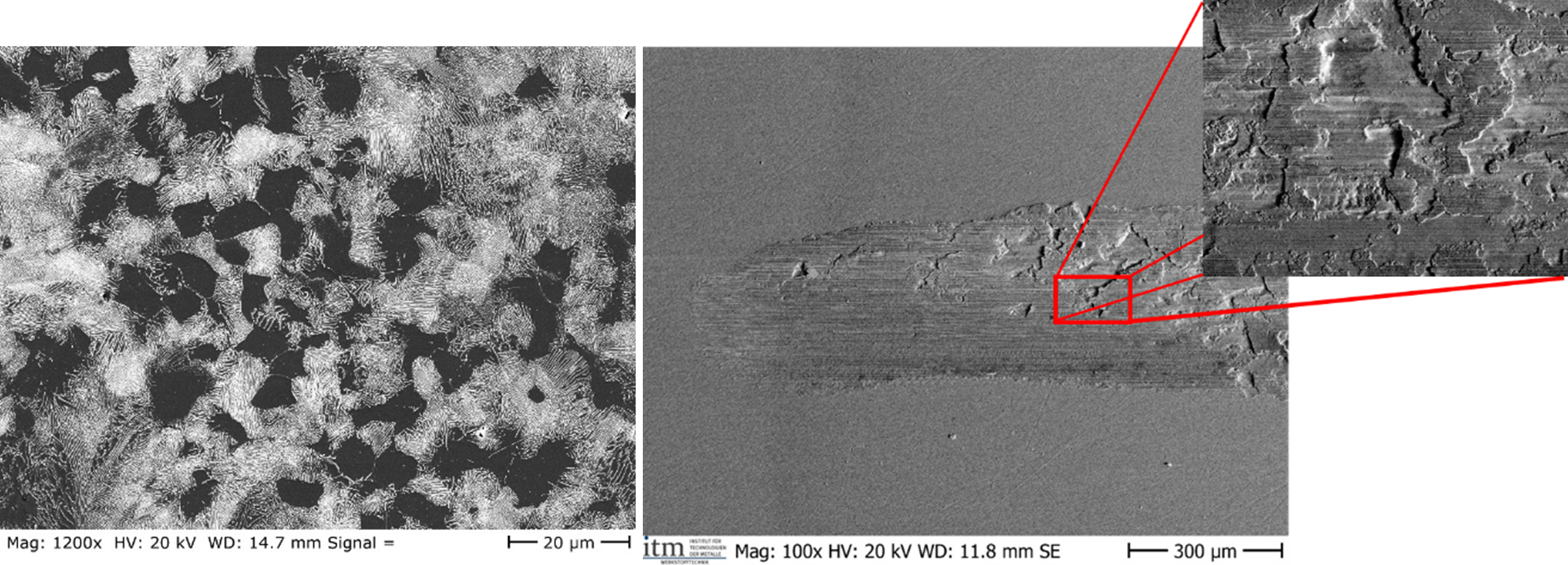
This project is being carried out in collaboration with University Duisburg-Essen, Max Plank Institute for Sustainable Metallurgy, and Ruhr University Bochum.
Contact: M.Sc. David Diaz

Developing methods for in-situ and real-time measurement of surface damage induced by cavitation using electrochemical techniques
Description
Cavitation erosion is a surface damage that affects many engineering components in contact with high-velocity flowing liquids. Detecting this damage in real-time and in-situ remains a significant challenge due to the limitations of conventional non-invasive techniques, such as optical inspection. These methods can be costly and ineffective, particularly in ultrasonic cavitation testing, where the damage occurs on the material surface, which is often inaccessible to optical observation in real-time. Additionally, the high vibration frequencies (20 kHz) of the ultrasonic equipment cause rapid surface changes. Furthermore, surface damage, such as the removal of passive layers and pit formation, occurs at micro/nanometric scales, which are beyond the detection capabilities of conventional methods. Therefore, electrochemical techniques that respond rapidly to transient surface changes, such as electrochemical noise, chronoamperometry, and high-speed OCP, are ideal for monitoring cavitation damage in real-time and in-situ.
This project aims to investigate the combined effects of corrosion and erosion on engineering alloys under ultrasonic and laser-induced single-bubble cavitation conditions. To capture and analyze the damage process in real-time, different electrochemical measurement setups will be synchronized with a high-speed camera. This synchronization will allow for a detailed correlation between visual data on the collapse of cavitation bubbles and the electrochemical response of the material surface. By combining these two methods, we can gain deeper insights into how cavitation affects the material at both the macroscopic (bubble dynamics) and microscopic (surface electrochemical behavior) levels. The results will contribute to the development of a more efficient and accurate approach for real-time, in-situ monitoring of cavitation-induced material damage, enhancing the ability to evaluate the effects of cavitation on a wide range of engineering materials.
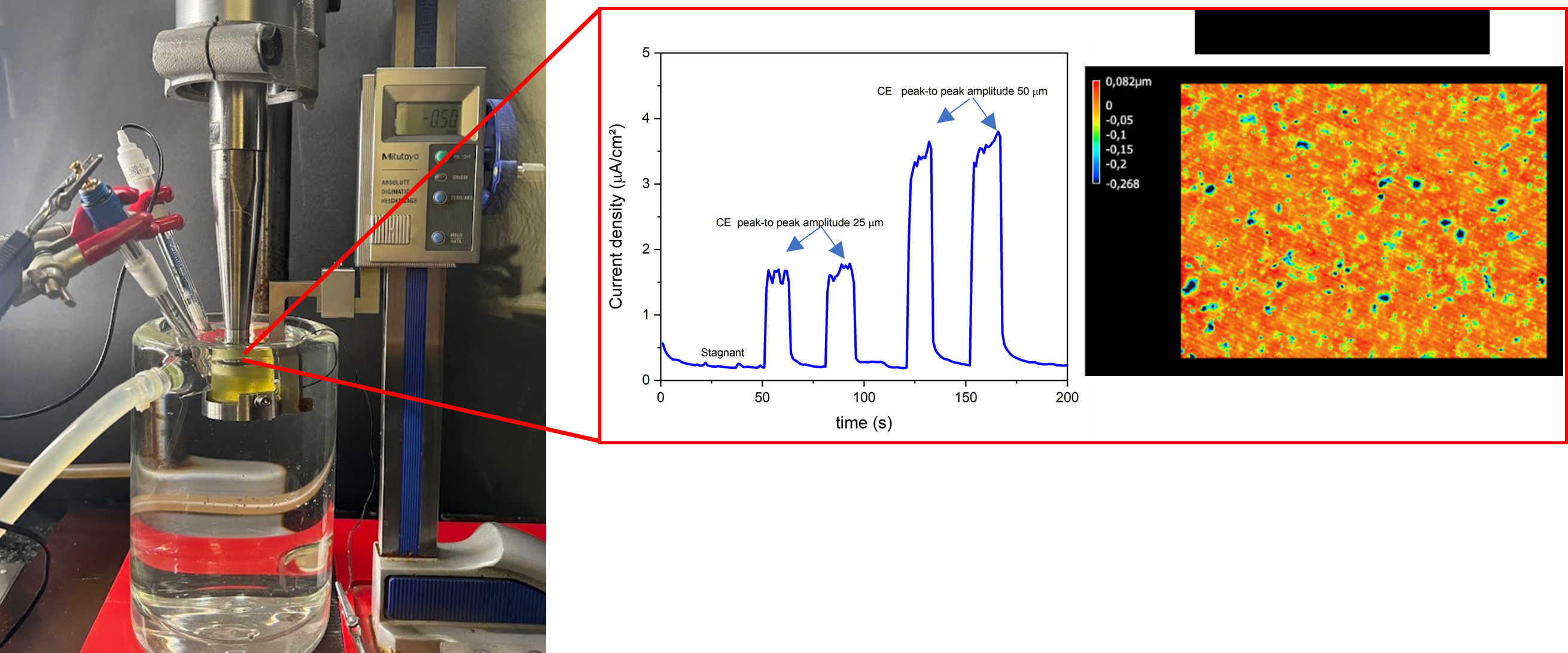
Research areas: Cavitation, Corrosion, Tribocorrosion, Electrochemical Measurements, Surface characterization.
Contact: M.Sc. Pamela dos Santos
Classification of wear characteristics for lubricated sliding wear based on normal and frictional forces using artificial intelligence
Description
Friction and wear have long been one of the main causes of economic losses in industry. However, due to the complexity of friction systems, modeling and predicting wear behavior remains difficult. Traditional modeling approaches are often based on morphological analysis of worn surfaces and measurement of wear characteristics (mass/volume loss). Artificial intelligence, as a new emerging research method, shows great advantages in coping with complex mapping relationships with multiple variables.
This DFG project aims to establish a mapping relationship between friction forces, normal pressure and wear behavior using AI models. First, the force data recorded in real time is reconstructed based on physical behavior. Subsequently, the analysis is performed on the reconstructed data together with SEM images to investigate the correlation between the force data and the wear morphology. Finally, a suitable AI model is selected and trained to establish the mapping relationship between the force data and the wear behavior.
Compared to the traditional methods, an AI model based on force data provides better generality and enables faster monitoring and evaluation of wear behavior in the future.

Research area: Tribology, wear mechanisms, wear prediction, machine learning, artificial intelligence
Contact: M.Sc. Shuai Zhu
Agrowaste particle incorporation in metal coatings for improved wear and corrosion resistance
Description
Metal coatings are used on substrates as barriers or sacrificial coatings to increase the life span of a material or improve its corrosion and wear properties. Researchers are currently improving the properties of these coatings by incorporating particles in form of elements like Sn, Al, Mg, and compounds like SnO2, SiO2, Al2O3 etc. Hereby, these metal coatings are necessary because substrates like steel are highly susceptible to corrosion and wear. Estimated monetary cost of corrosion globally is currently around 3 to 4% of the GDP per year. However, often, these particles being incorporated into these metal coatings to improve its applicable properties come from salts which are not environmentally friendly, not readily available, and sometimes toxic.
As a solution, my research is focused on demonstrating that agricultural waste can be a source of this second phase particles. Within this research, we are incorporating particles coming from agrowastes like cow bone ash particles (CBAp), studying the interaction of these particles with the Nickel coatings, observing phase formations and resultant microstructure using techniques like SEM/EDS, XRD. We are also studying how the incorporated particles affect the corrosion and wear resistance of these coatings. In summary, our research is working to close the recycling loop and revalue and repurpose agricultural waste, while providing a cheap and ecofriendly second phase particle substitute for metal coatings.
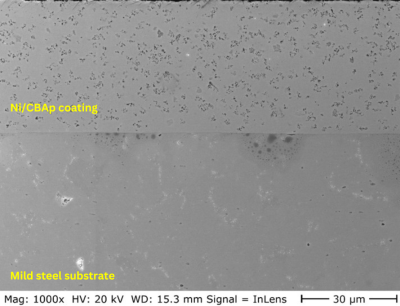
Research area: Metal Coatings
Contact: M.Sc. Favour Whyte
Microstrutural mechanisms of strain accumulation under cyclic and monotonic pressure-torsional stress
Description
Previous work and studies in materials science show that plastic deformation of metals and alloys, particularly extreme shear deformation (”Severe Plastic Deformation“, SPD), can influence properties and increase strength. Conventional SPD processes include Equal Channel Angular Pressing (ECAP), Accumulative Roll Bonding (ARB) and High Pressure Torsion (HPT). HPT is particularly effective in reducing grain sizes, and the applied load is a constant, axial compressive stress with simultaneous monotonic torsion.
In this project, a cyclic pressure-torsional method is applied, termed "High Pressure Torsion Fatigue" (HPTF). Decisive differences to classical SPD methods are the cyclical change of the torsion direction, as soon as a certain strain is reached, and a cylindrical sample geometry. The multiaxial load and high number of cycles lead to different total strains, and strain accumulation in the microstructure. Test results at room temperature show that grain refining can be achieved under this kind of loading under conditions that are not fully understood to date.
The main focus of this study is on the microstructural mechanisms of strain accumulation and recrystallization in Al, Ti, and Fe based alloys, which are investigated and elucidated by scanning electron microscopy and transmission electron microscopy.
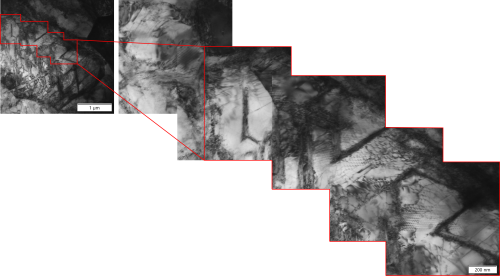
Research area: Material Science
Contact: M.Sc. Ahmet Karkar
Influence of Mg and Si on deformation and recrystallisation behavior of aluminium alloys under severe plastic deformation during Friction Surfacing
Description
Friction Surfacing (FS) is a friction-based solid-state joining technology with the potential to locally modify component properties. During FS the joining partners, a consumable stud and the substrate, are joined together in solid state. The stud material undergoes severe plastic deformation (SPD) at elevated temperatures (≈0.8 Tmelt) and dynamic recrystallization (DRX). Besides the general material properties like heat capacity and strength, material-specific dynamic microstructural mechanisms, such as substructure formation or phase transformations, strongly affect the effective yield stress. The influence of alloying elements in metals under these extreme thermal and mechanical loading conditions has not been sufficiently studied to date.
In this study, 7 custom-made aluminum alloys are processed by FS. The alloys differ in their Si and Mg content, so the influence of the alloys’ composition can be investigated. In experimental welds, which are carried out at Helmholtz-Zentrum Geesthacht, process characteristics, layer geometries, specific energy inputs and material efficiencies are evaluated. Correlations between these parameters and microstructural processes are determined by scanning electron microscopy, electron backscatter diffraction, and transmission electron microscopy at the University of Duisburg-Essen. Precipitation and dissolution of phases within the solid solution, caused by high thermal gradients are investigated by analytical methods such as differential scanning calorimetry, energy dispersive X-ray spectroscopy and X-ray diffraction. Due to the homogeneous distribution of alloying elements, phases and globular grains, advantageous mechanical properties of the layer material can be expected. Hence, micromechanical experiments (microtensile tests, wear tests, hardness mappings, etc.) are carried out in order to analyze and correlate the obtained microstructure with mechanical properties.
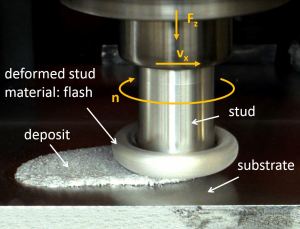 Process: Friction surfacing
Process: Friction surfacing
Research area: Material Science
Contact: M.Sc. Jonas Ehrich
Multi-axial compression-torsion fatigue loading of Cronidur 30 stainless steel in different microstructural states
Description
Most engineering components practically experience multi-axial cyclic stresses in service that arise from two main causes: (i) multiple and different loading conditions (ii) geometric constraints and complexity of the components. Due to the large number of possible conditions and the intricacies of the interpretation of the material behaviour, multi-axial fatigue behaviour is not fully understood for many materials.
In this work, a constant axial pressure and a cyclic torsional load are combined. The multi-axial loading is expected to activate several slip systems within the crystal structure. The pressure to be applied is adapted to the strength of the material in each microstructural state in such a way that the samples are only loaded axially in the elastic range. A closer examination of the fracture surfaces is used to investigate whether the torsional or the compressive load is dominant in the material fatigue. These observations are then correlated with the calculated equivalent stresses and strains.
The microstructural mechanisms of damage accumulation are to be investigated in detail in this project by means of high-resolution microscopy using a scanning electron microscope (SEM), electron backscatter diffraction (EBSD) and the transmission electron microscope (TEM). The results are first correlated with the macroscopic material properties determined by conventional experiments.
The relationship between microstructural mechanisms, macroscopic material properties and mechanical material behavior under superimposed compression-torsion loading is investigated in this project using P558, an austenitic steel with high nitrogen content (X20CrMnMoN17-11-3, 1.3808).
The cracking behavior and fatigue life are predicted using critical level models, such as the Fatemi-Socie and Smith-Watson-Topper models, and compared with experimental data.
The advantages of cold forming have already been described by other researchers. Again, specimens are cold deformed at 5%, 10%, 20% and 40% strain to find out up to what point cold deformation is beneficial for increasing fatigue life.
A phenomenological model of crystal plasticity is also used to describe the damage under multiaxial loading conditions, especially in sliding and/or twinning conditions. Again, the crystallographic texture plays an important role.

Research area: Material Science
Contact: M.Sc. Timothy Ngeru
Deformation and damage mechanisms in austenitic steel with High Pressure Torsion Fatigue (HPTF)
Description
In practice, components are often exposed to multi-axial mechanical loads, typically occurring as a function of time and reversing. Experimental investigations under such complex load collectives are very time-consuming, so that the mechanisms that lead to plastic deformation and failure of materials under such conditions are only poorly understood. As a result, there is also an uncertainty as to whether common solid-state mechanical failure hypotheses are valid under these conditions.
In this project, the deformation and damage mechanisms in a high nitrogen austenitic steel under superimposed pressure and cyclic torsional loads are experimentally investigated. Influences of the specific load condition on the microstructural mechanisms of strain and damage accumulation are analyzed by high-resolution microscopy. Based on the experimental results, a constitutive model within the framework of crystal plasticity is formulated by the cooperation partner at Ruhr-University Bochum, which reliably describes cyclic plasticity and damage under multiaxial loads on the microstructure level.
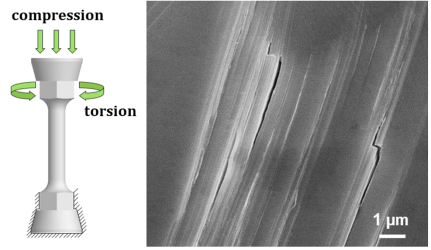
Research area: Material Science, plastic deformation, austenitic steel, damage mechanisms
Contact: M.Sc. Dzhem KurtulanMetallkundliche Untersuchungen zum Hochtemperaturverformungsverhalten strahlgeschweißter hochwarmfester Werkstoffe
Description
Due to the more productive manufacturing processes and the achievable cost reduction in the manufacture of high-quality components, laser and electron beam welding are becoming increasingly important for high-temperature materials. This is contrasted by the fact that, to date, there is almost no information available regarding the creep and fatigue properties of beam-welded connections made of heat-resistant materials in the range from room temperature to the operating temperature. The aim of this research program is to provide the designer with data on the static and cyclical dimensioning of beam-welded components made of selected high-temperature alloys in the temperature range up to 900 ° C on the basis of metallurgical studies. The results obtained should serve as a model for similar alloys in this group of materials. Since the influence of welding processes on the microstructural changes and on the mechanical-technological characteristics of high-temperature resistant materials has not yet been fully clarified, the answer to this question, along with studies on the influence of post-heat treatment after welding, is the focus of the planned research project.
Research area: Material Science
Contact: Dr.-Ing. Thomas Spirowski
Mikrostrukturelle Veränderungen in der Zylinderlaufbahn von PKW Dieselmotoren aus Grauguss und mittels thermischer Spritzverfahren hergestellter Stahlschichten
Description
Research area: Material Science
Contact: Dr.-Ing. Mareike Hahn
Description
This study belongs to the areas of tribology and orthopaedic research. It deals with the tribological system of metal-on-metal hip joints made from CoCrMo alloys. Such hip joints operate within the ultra-low sliding wear regime, but yet can be subjected to failure due to particle formation and resulting adverse tissue reactions. In order to gain a better understanding of complex processes within the tribological interface leading to the formation of wear particles the focus is set on four aspects: microstructure, surface alterations, subsurface alterations and wear particle structure and composition. Therefore high resolution techniques like SEM, TEM, AFM and FIB are utilized. The findings of this work contribute to a better understanding of current clinical issues with some metal-on-metal hip devices, but can also be applied to other tribological applications by explaining tribologically induced processes enabling low wear rates and the formation of nanometer size wear debris.
Research area: Material Science
Contact: Dr.-Ing. Robin Pourzal
Einfluss der Kaltverformung auf das Ermüdungsverhalten von austenitischen hochinterstitiell legierten Stählen
Description
The combination of already known and new knowledge makes it easier to understand and design functional materials like austenitic high interstitial steels (AHIS). AHIS are functional metals because of their advantageous mechanical, chemical and physical material properties. These properties are the main reason, why AHIS are used for diverse applications in different industrial domains.
Especially mechanical properties of materials play an essential role for technical design of applications. In solution annealed state AHIS show better monotonic and cyclic strength than conventional FeCrNi-steels. In cold worked state only the monotonic strength is better than FeCrNi-steels. The endurance limit doesn’t increase in the same ratio as the yield strength in cold worked AHIS.
In this study, the influence of cold working to the fatigue behaviour of AHIS with C+N-content of 0.85 – 1.07 wt-% was investigated. The specimens were cold worked by a defined strain rate. After cold working the specimens were fatigued by total strain controlled fatigue tests at room temperature. Monotonic and cyclic mechanical properties e.g. tensile strength and endurance limit of AHIS were measured by means of mechanical testing. After mechanical testing the samples were investigated using light microscopy, SEM including EBSD and TEM. The monotonic strength of AHIS increases with cold working and increasing content of interstitial alloying elements C+N. Cold working and an increasing content of interstitial alloying elements C+N have an opposite effect on the endurance limit of AHIS. With increasing content of interstitial alloying elements C+N and increasing cold working state the cyclic strength e.g. endurance limit decreases in AHIS. The distinct ability of dislocation hardening and solid solution hardening of AHIS promotes the formation of secondary cracks at the surface and in the bulk of the specimens. Most secondary cracks were found along persistent Lueders bands. The advantage of cold worked AHIS is the higher robustness against damage. A high amount of secondary cracks leads to relaxation within material and permits crack branching. Thus, the lifetime of the AHIS material and component can be extended.
Research area: Material Science / Fatigue
Contact: Dr.-Ing. Sedat Güler
Mn and N Influence on the Crack Propagation Mechanisms in Austenitic Steels
Description
In conventional Ni-alloyed austenitic steels cold hardening leads to an increase of the number of cycles to failure in both, the finite and the infinite life fatigue strength, whereas in high-N-alloyed austenitic steels the number of cycles to failure increases just for the finite life fatigue strength. The reason for these discrepancies may be found in the deformation mechanisms (wavy vs. planary slip) during cyclic loading, which differ significantly and are influenced by the stacking fault energy, near field effects between substituted and interstitial atoms in the solid solution and the density of free electrons in the sliding planes.
The aim of this project is the investigation of these effects and their correlation with the cycling mechanical properties. Therefore austenitic CrNiMoC-, MnC-, CrNiMoN-, and CrMnMoN-steels will be investigated as to their cyclic mechanical properties (crack initiation and propagation) in the solution annealed state, followed up by the microstructural analysis of the load and strain dependent microstructural changes by means of SEM incl. EBSD and TEM.
Research area: Material Science / Fatigue
Contact: Dr.-Ing. Michael Schymura
The Divergent Pathways and Mechanisms of Energy Dissipation at the Interfaces of Martensitic Tribocouples
Description
The requirements for technical systems subjected to friction and wear become more demanding, therefore the components are exposed to increasing stresses. Besides possible safety matters, failure of tribologically loaded systems cause tremendous maintenance costs. Due to the lack of reliable wear prediction models, tribometer tests are used in order to investigate wear behavior of materials and lubrication conditions. For well-aimed optimizations of tribological contacts a comprehensive understanding of wear processes is necessary. However, the transferability of many studies into technical applications is arguable due to applied loads, lubrication conditions and material selection. In this study specimens with different topographies and subsurface structures were investigated prior to and after tribological testing. The tests have been carried out under application related conditions regarding material properties, lubrication and loading conditions. The analyses of surface and subsurface characteristics were performed using complementary microscopy techniques, such as EBSD and TEM. Findings from microscopic analyses were linked to the frictional and wear behavior in order to gain information about energy dissipation and dissipative mechanisms within the respective system. The presence of a grain-refined layer appears to have a beneficial influence on the adaptation of the counterfaces and enhances the robustness of the tribosystems. In addition wear debris was analyzed and different mechanisms of particle generation were discussed.
Research area: Material Science
Contact: Dr.-Ing. Priska Stemmer
The influence of surface finish on the localized dissipation of frictional power at ultra-mild wear
Description
Tribological systems are subjected to a steady decrease of friction and wear due to ecological and economical requirements. These guidelines can change the tribological loads and, therefore, result in more severe conditions. The need for maintaining wear as low as possible towards ultra-mild wear rates an integral approach is needed, which has to regard the contact conditions, surface topography, near and sub-surface physical properties. The ultra-mild sliding wear rates, in the order of some nanometers per hour, are desired for example for gears of wind turbines, valve and drive train components, and artificial hip joints to maintain or increase service life time and sustainability. These small wear rates imply a non-linear characteristic of wear, because the amount of wear per load cycle falls below the inter-atomic distances of (technical) materials and consequently can not be a continuous process anymore. Here highly localized effects of dissipated friction energy govern the acting wear mechanisms and alterations of tribosystems, which are still not quantified on the micro- and nano-scale. However today mostly empirically determined wear factors are used to calculate the amount of wear for a given tribological load and hence material failure on those scales can not be predict. This technical matter is complicated by the fact that classical investigations of wear like weighing and micro structural analysis are difficult at the scale and extent of occurring wear appearances within the ultra-mild wear regime. Combined wear tests, micro structural analysis and numerical calculations are presented for the individual analysis of the material response to tribological loads. If a quantification of the failure sequence succeeds on those scales, new design guidelines could be developed, in order to further increase the service life time and predict failure modes more precisely.
Research area: Material Science
Contact: Dr.-Ing. Daniel Stickel
Microstructure and Properties of Coatings produced by Friction Surfacing
Description
Friction Surfacing is up to now a rather unknown solid-state joining technique, by which metallic coatings of several hundred micrometer thickness can be produced. During the process, coating materials temporarily reach temperatures just below the melting point and undergo high degrees of deformation at high strain rates. Under such conditions, unique material properties of the coatings can be observed, which are, amongst others, due to homogenisation and grain refinement. The mechanisms, which lead to this particular state of microstructure (e.g. dynamic recristallisation) are, in the case of friction surfacing, not fully understood and differ significantly for different materials (aluminum, copper, steel...).
In the scope of this P.h.D. thesis, interrelations between microstructure and material properties of coatings produced by friction surfacing are investigated using a combination of mechanical testing (e.g. wear tests) and microscopic examinations (e.g. Electron-Backscatter-Diffraction to look at the degree of recristallisation).
Research area: Tooling
Contact: Dr.-Ing. Stefanie Hanke

